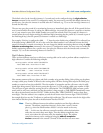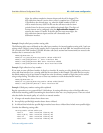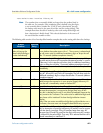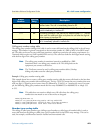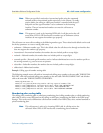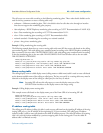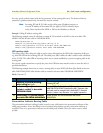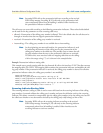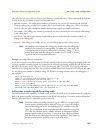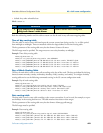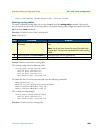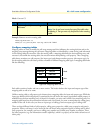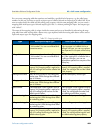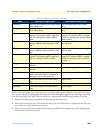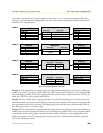
Call router configuration task list 477
SmartWare Software Configuration Guide 40 • Call router configuration
The call router can route calls according to the following screening indicators. These values beside default can
be used for the key parameter to create a routing table entry:
• user-not-screened—The calling party number is provided by the user but not screened by the network.
Thus the calling party possibly send a number that is not owned by the calling party. (This is the default
value for calls that arrive through an interface that does not support presentation indicators).
• user-passed—The calling party number is provided by the user, screened by the network and really belongs
to the calling party.
• user-failed—The calling party number is provided by the user, screened by the network and does not
belong to the calling party.
• network—The calling party number, because it is provided by the network, can be trusted.
Note You possibly want to remove the calling party number when the calling party
number is not screened or screening failed. To achieve this, route these calls
to a mapping table that sets the calling-e164 to the empty string (“”). If you
want to drop calls when the calling party number is not screened or screen-
ing failed, use the routing destination none.
Example: Screening indicator routing table
A call that is routed to this table is examined for the screening indicator of the calling party number. If the call-
ing party provided a number that was not accepted by the network (user-failed), we drop the call. Else we route
the call to the interface IF-OUT but first execute the mapping table NO-CNPN. This mapping table again
examines the screening indicator. If the user provided a number that was not screened by the network, the table
sets the calling party number to an empty string. For all other screening indicator values, the calling party is
not modified.
node(cfg)#context cs
node(ctx-cs)[switch]#routing-table calling-si SI
node(rt-tab)[SI]#route user-failed none
node(rt-tab)[SI]#route default dest-interface IF-OUT NO-CNPN
node(rt-tab)[SPI]#exit
node(rt-tab)[switch]#mapping-table calling-si to calling-e164 NO-CNPN
node(map-tab)[NO-CNPN]#map user-not-screened to “”
Information transfer capability routing table
The information transfer capability (itc) table is used to route calls based on the information transfer capability
field of the bearer capability information element in the ISDN setup message. This can be used to differentiate
between ISDN data services and ISDN speech connections.
Note Terminals connected to analog extensions (e.g. of a PBX) do not supply infor-
mation transfer capability values in their call set-up, so it is up to the configu-
ration of the analog port on the Terminal Adapter, NT or PBX to insert this
value. The configuration of this value is however often omitted or wrong. The
ITC value may therefore not be a reliable indication to differentiate between
analogue speech, audio or Fax Group 3 connections. Also, calls from SIP and
FXS interfaces do not differentiate between bearer capabilities. They always set
the information transfer capability property to 3.1kHz Audio.



